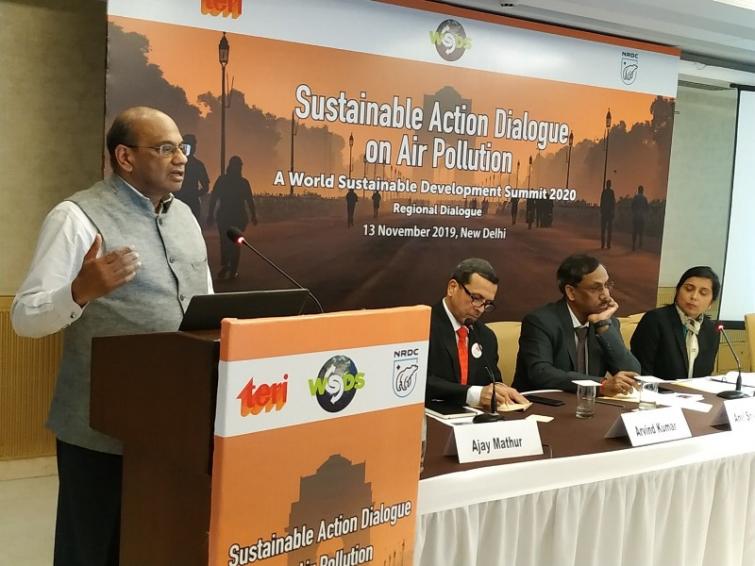
Possible to reduce Delhi PM 2.5 winter level by 46%, tackle both peak and non-peak pollution sources: TERI
Kolkata/New Delhi/IBNS: The Energy and Resources Institute (TERI) has prepared a strategic plan for solving Delhi’s air pollution crisis which worsens during winters every year.
Speaking at the Sustainable Dialogue on Air Pollution, co-organised with Natural Resources Defense Council (NRDC), Ajay Mathur, Director General, TERI said, “Delhi’s air pollution is a solvable problem. There are solutions both in terms of technologies and for meeting the necessary costs. TERI is putting forward definitive measures for addressing peak and non-peak pollution sources, both of which are absolutely essential to improve Delhi’s air quality. We can immediately start working towards implementation, if all stakeholders come together.”
Sumit Sharma, Director, Earth Science and Climate Change Division, TERI added, ‘’Some of the peak air pollution episodes during winters can be avoided by controlling agriculture crop burning and fire crackers. But this can only bring down the pollution levels to ‘very poor’ category. However, if we address both peak and non-peak sources such as transport, industries, residential and road dust, it is possible to reduce Delhi’s PM 2.5 level by 46% during winters, which can restore air quality to ‘moderate’ category.’’
C K Mishra, Secretary, Ministry of Environment, Forests and Climate Change (MoEFCC), Government of India in his keynote address at the dialogue said, “In the last two years, efforts by the government in tackling air pollution have been phenomenal but the results achieved are marginal. We need at least 50% reduction in current air pollution levels. This needs sustained efforts. Emergency and knee-jerk reactions will not help.”
He further added that air pollution cannot be the government’s business alone. “Everyone has a role to play. Even if there is an adverse cost, it should be paid,” he said.
Talking about global experience in tacking air pollution, Mitchell Bernard, Interim President and Chief Counsel, NRDC said, "It has helped when air pollution has been linked to the health and economy of a country. It is not a narrow environmental issue. There is a huge public health cost. And there is a strong economic argument to be made for combating air pollution on account of lost productivity, medical costs, and opportunity costs."
Speaking about the looming health crisis, Arvind Kumar, Chairman, Centre for Chest Surgery, Sir Ganga Ram Hospital said, “In 1988, patients of lung cancer were mostly known smokers. In 2018, 50% cases of lung cancer are non-smokers.’’ He warned that Delhi is likely to see an explosion of lung cancer cases in the coming years."
Measures for addressing peak pollution sources:
TERI’s assessment suggests that the impact of stubble burning in adjoining states of Delhi can be brought down by 40% during the days of peak burning activity. Key recommendations to control crop burning include-
Enabling biomass aggregation and collection by mandating state/central organisations and creating special credit line/scheme for financing farm equipment
Creating a market for biomass briquettes to be used as fuel in thermal power stations, local industries, and hotels/dhabas.
Converting biomass crop residue into fuel to run decentralised cold storage facilities for horticulture produce and milk chilling applications
Further, TERI has recommended community burning of firecrackers by allowing only Resident Welfare Associations (RWAs) to purchase a fixed quota allotted to them. TERI has advised to permit sale of one-fifth the amount of fire crackers sold in 2019.
Measures for addressing non-peak pollution sources:
TERI’s plan suggested the following measures to control non-peak pollution sources:
Transport- By incentivizing transition of pre-BS-IV commercial vehicles to BS-VI, accelerating the penetration of electric buses in Delhi NCR under FAME 2 scheme, and strengthening inspection and maintenance (I&M) system, the transport sector has a tangible reduction potential of 19% in PM2.5 concentrations. TERI also suggested accelerating the phase-out of pre-BS-IV private vehicles. Those who discard such vehicles to buy BS-VI vehicles could be incentivized through an excise rebate.
Industries- About 2,226 factories/plants in NCR (about 50%) have not yet shifted to natural gas. Proper infrastructure needs to be built to supply natural gas to these factories. Industries should also be encouraged to transition to electric use, where feasible. Overall, industries in Delhi NCR have the potential to cut down PM 2.5 concentration levels by 11%.
Thermal power plants- All thermal power stations in NCR should comply with already notified emission standards by MoEFCC and use agricultural residue blend, instead of coal. This can bring down PM 2.5 concentration levels by 3%. If these plants do not comply, they should be closed during the five-month winter period.
Residential- 16 lakh households in NCR still use biomass burning for cooking purposes. These households need to switch to LPG. During winter season, TERI recommended providing two free cylinders, especially to 6 lakh BPL households. This measure can bring down the share of pollutants from residential sector by 5%.
Road dust- TERI further suggested effective utilization of existing machines for road sweeping for dust control. It said that smaller mechanized road sweeping machines should also be considered which are preferably electric to avoid further pollution load.
Support Our Journalism
We cannot do without you.. your contribution supports unbiased journalism
IBNS is not driven by any ism- not wokeism, not racism, not skewed secularism, not hyper right-wing or left liberal ideals, nor by any hardline religious beliefs or hyper nationalism. We want to serve you good old objective news, as they are. We do not judge or preach. We let people decide for themselves. We only try to present factual and well-sourced news.







